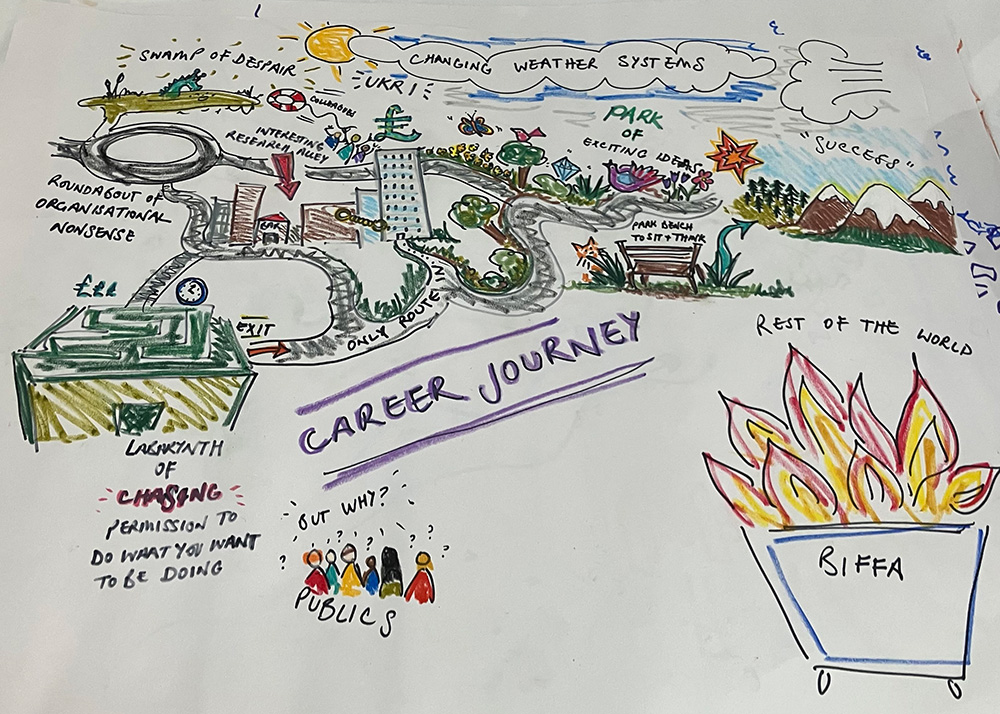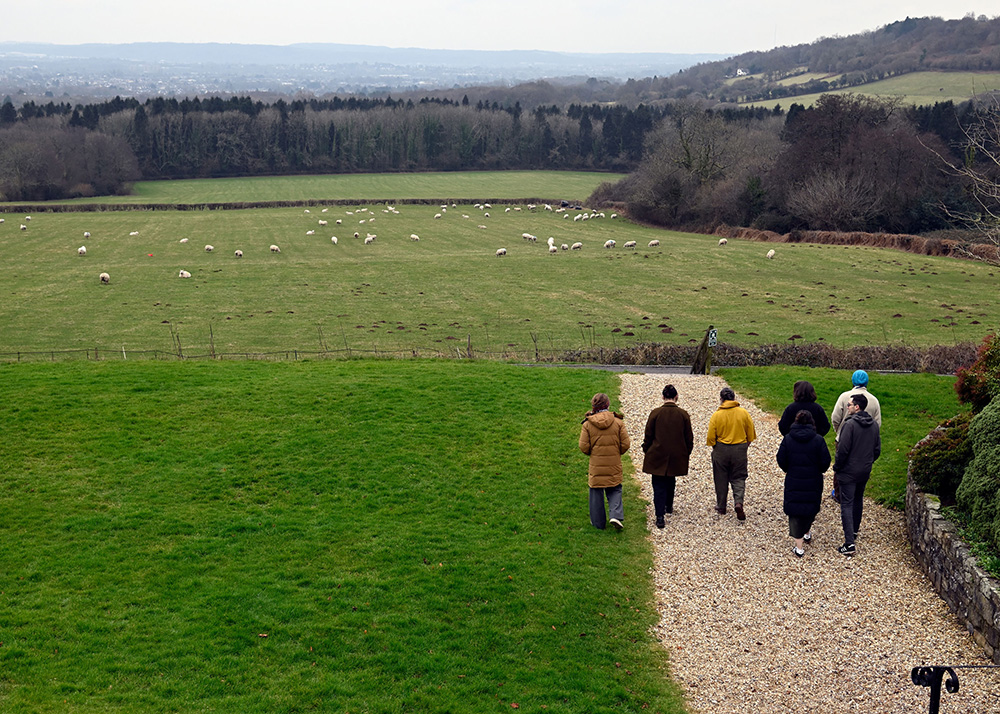Fostering creative societies
Three of the Centre’s early career researchers are taking part in a series of events, run by the GW4 Alliance, focused on leadership, networking, and creative thinking. In this joint-blog post, they share reflections from the first of these sessions, which explored “Creative Societies and Cultures, Cultural and Public Good“.
A SOFT walk
The two-day lab was thoughtfully paced – with time to pause and chat alongside the structured sessions, we each noticed how we weren’t experiencing the ‘brain fry’ that often comes with intensely-paced academic events.
One of the highlights for me was the invitation to head out into the misty Welsh countryside for a SOFT walk: Solo, Open-minded, Free-wheeling and Tech-free.
I headed towards Craig Llanishen, an escarpment overlooking the hotel, the hills and city. Several of us were drawn to this high point perhaps seeking a literal and metaphorical sense of perspective.
This wasn’t an aimless stroll though: we were prompted to contemplate “What do I bring to collaboration on creative societies and cultures?” I found myself reflecting on the diverse academic disciplines that my studies and work have spanned, and how challenging it can be to identify with a single discipline.
While this can feel like a source of insecurity, it also fosters a sense of openness, as I’m rarely tied to the belief that one approach is superior. Working across different subjects, projects, and methodologies brings flexibility and breadth of perspective. I thought about how many of the people I’ve chosen to collaborate with have similarly varied academic histories.
I reflected on how creativity within research culture requires enthusiasm as well as commitment, and how this becomes easier and more attainable when you find the right people to work with.
By the time we returned to the hotel, our minds were buzzing with fresh ideas, and we were ready for coffee and a quiet moment to jot down our reflections.

Illustrated map of the research landscape, © Harriet Hunt.
Maps of the research landscape
One of the most memorable sessions from our first lab was creating an illustrated map to depict the research landscape we all navigate.
Working in groups of three, we considered the economic, societal, environmental, technological, and organisational drivers shaping our research work. It was like being back in primary school, reliving the best bits of creative freedom!
As our group chatted, our collective experiences unfolded across the page. In one corner emerged the Roundabout of Organisational Nonsense, capturing the endless loops of bureaucratic processes imposed by institutions. Leading off from this was the Swamp of Despair — a place where it’s all too easy to get bogged down but where compassionate colleagues can pull you to safety.
At the heart of our map lay the Park of Exciting Ideas, filled with winding pathways and unexpected discoveries, complete with a Park Bench to Sit and Think — a vital but often overlooked element of research work. We also sketched a Labyrinth of Chasing Permission to Do What You Want to Be Doing, where the only way out was through securing independent funding.
Beyond the skyscraper of major funders and Interesting Research Alley, the sunlit uplands of Success gleamed ineffably on the horizon, while ever-changing weather systems above symbolized the personal and societal contextual factors that constantly influence our individual research journeys.
Finally, we couldn’t ignore the Rest of the World – a chaotic bin fire watched by a group of onlookers, representing publics asking, “But why?” This imaginative exercise was an unexpectedly profound way to explore the complexities of the research landscape — blending humour, honesty, and reflection.

A group heading out for an unconference, © GW4 Alliance.
Unconference
The second day of the event was dedicated to an ‘unconference’ – a model that’s been around for twenty years and emphasises informal networking interactions to expand professional networks.
An unconference is participant-orientated: the audience chooses the format, topics, time, and venues. Our excellent facilitator, Kate Tapper, walked us through initial activities, guiding us to land at several themes, including commodification of creativity, funding of creative research, and creative methods.
We were then asked to sit in the theme that resonated most with our interests. I initially struggled to choose as they all seemed important and intriguing, but landed on the theme of ‘play’ to explore how we can create more joyful research environments that allow creativity to emerge.
(But on reflection, I was also drawn to this table because I wanted to have some fun and thought this group would be thinking the same thing!)
In our groups, we dove into the unconference and were provided with time to have deeper conversations about our themes. Some groups chose to walk and talk, whilst ours retreated to the lounge area to begin discussions about play.
Those conversations are a blur now, but I remember feeling inspired and seen by the other members of the group. We had been instructed to practice active and deep listening, letting each person speak, whilst others were silent and respectful.
At the end of the day, we came back together and shared our discussions, which ended up with our group playing ‘One Word at a Time’ with the wider group – practicing play in action.
What’s next?
We’ll continue in-person sessions and the unconference throughout 2025, talking about how to take our new collaborations and networks forwards, and taking advantage of more reflective walks. The Crucible programme has been inspiring and energizing – a space for true creativity and innovation. We highly encourage other ECRs to apply in the future.